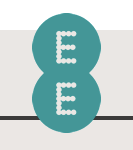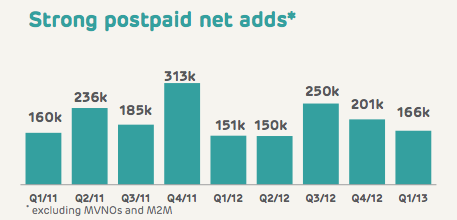EE, the U.K.’s first and still only 4G network operator, has broken out 4G-specific customer numbers for the first time — confirming that after five months of 4G trading it has hit a total of 318,000 4G-specific customers out of a total of 13.7 million postpaid mobile subscribers in the quarter (so around 2.3% of its postpaid mobile customers are on 4G). The 4G figure was broken out in EE’s Q1 results which ended March 31. The carrier has previously reported total postpaid 3G and 4G additions for its Q4 quarter, when it said it saw 201,000 net gains in the quarter. Overall EE has a mobile & fixed line broadband subscriber base of 26.4 million.
It’s worth underlining that the 318,000 figure does not consist of only new customers joining EE but includes existing 3G customers who have upgraded to its 4G offering. In its Q1 results release today, EE said “strong take-up of 4G services amongst new and existing customers validates our data monetisation strategy”, noting that it is continuing to “successfully migrate Orange and T-Mobile customers with 4G-ready phones to high value EE 4G price plans in areas where 4G coverage is available”.
It added that it is “firmly on track” to meet its target of more than one million 4G customers by the end of 2013 — a target that is arguably rather unambitious, as IHS Screen Digest analyst Daniel Gleeson noted on Twitter.
EE reported postpaid mobile net adds of 166,000 for its Q1. The quarter is traditionally a weaker one for the carrier to add new customers but EE noted that Q1 2013 outperformed its past two year-on-year Q1 quarters, which saw 150,000 and 160,000 net postpaid adds respectively:
EE also said growth in underlying ARPU (average revenue per user) was up 2.2% year-on-year, while non-messaging data revenue increased to 36% of ARPU (vs 27% in the year ago quarter). In the quarter, the percentage of its postpaid customers using a smartphone rose a high of 82%, up from 78% in the previous quarter and 71% in the year-ago quarter. Driving and monetising data usage is key for carriers as traditional voice & messaging revenues continue to decline.
Commenting on the results in a statement, EE’s Chief Financial Officer, Neal Milsom, said: “Today’s results are in-line with our expectations, and we are making good progress focusing on high value segments. We’re announcing 318,000 4G customers after just five months of trading, strong postpaid net adds and continued growth in our underlying average revenue per user. We expect to strengthen our industry leadership position in the year ahead as the 4G roll out continues and we introduce double-speed 4GEE.”
EE said it continues to see “strong demand” for 4G from U.K. businesses, noting that more than 1,600 are now using LTE including NG Bailey, PA News, Reed Recruitment, RAC, Tate & Lyle and United Utilities.
Regarding its 4G rollout, EE said its LTE network is on track to reach more than 70% of the U.K.’s population by the end of 2013, and 98% by the end of 2014. Last month EE announced its 4G network was now within reach of 50% of the population. The carrier is not blanketing all the cities and towns it names in its rollout with 4G coverage, but is switching on specific postcode areas in order to initially cover 80% of the centre of the city or town — counting only those postcode areas towards its overall population coverage target. In practice this means that there are still plenty of areas even in rollout locations where customers won’t be able to use 4G but will fall back on to its 3G network (which EE is also bolstering by increasing network density).
Earlier this month, and as part of its marketing blitz to bang the drum about 4G before its rivals are able to launch their own LTE networks this year, EE announced it planned to double the speed of its LTE network in 10 cities by the end of June, to a headline speed of up to 130Mbps. The auction for 4G-suitable spectrum was completed earlier this year, and EE’s rivals are in the process of readying or building their own networks — with launches likely from late Spring/Summer, according to telecoms regulator Ofcom.
Two-year mobile contracts are common in the U.K. which means potential 4G customers are likely to wait for their existing contract to run its course before upgrading — which makes it important for EE to keep making a noise about its network to catch the eye of possible customers who are in a position to upgrade or switch.
The carrier’s sales staff have also been calling existing 3G customers to encourage them to upgrade — even, in one case recounted to TechCrunch, where upgrading to 4GEE made no sense, since the customer in question did not live in a 4G-enabled area or regularly visit any 4G-enabled areas. The customer was not told this during the sales call. It was only subsequently, when they noticed no speed difference and asked about 4G coverage, that EE admitted neither the customer’s home town or workplace location were on its rollout map — and would likely never get LTE. So at least one of those 318,000 4G customers isn’t actually able to use 4G.
To coincide with its Q1 results, EE commissioned a survey of its 4G users which indicates that close to half (42%) are downloading more apps when out and about, while more than a third (37%) reported using less or no public Wi-Fi since getting 4G. One in five also said they are using their home broadband less.

